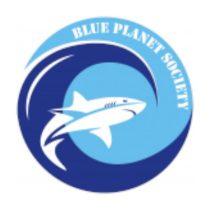The grindadráp or grind, as it’s usually called, is a hunting method created by the Vikings over 1,000 years ago, which the Faroese have preserved as a part of their culture. This archaic tradition consists of driving entire pods of small cetaceans (mainly long-finned pilot whales, which belong to the dolphin family, and Atlantic white-sided dolphins) to shore, where they face a painful death. When the animals are sighted, boats and other watercraft intercept them by forming a semicircle between them and the open sea. The noise created by the engines forms a ‘wall of sound’ that frightens those animals, which are extremely sensitive to sound and use echolocation to orient themselves, and herds them to one of the 26 designated killing bays where they’re eventually trapped.

Whaling in the Faroe Islands. Credit: Erik Christensen
Once trapped, Faroese men (primarily men participate in the hunt), eagerly slaughter them in the shallows or drag them to the beach with ropes and gaff hooks, which are plunged into the animal’s sides and blow holes. Due to the whales’ movement and smooth skin, it’s usually necessary to strike multiple times before the hooks are attached, prolonging their suffering further.
The killers use traditional knives to make deep cuts on the sides of the neck, just behind the blow hole. The spine is then severed and the main arteries are opened. This violent killing method brings unimaginable pain to the animals, which in most cases die of blood loss. Besides the physical injuries, there’s also the emotional torment and stress of seeing their families die in front of them with no possibility of escape, just waiting for their turn while lingering in bloody waters. This all happens so their meat and blubber can be consumed by the locals.

Bottlenose dolphins after a hunt in the Faroe Islands. Credit: Palli Ásbjørnsson Justesen
While the Faroese government states the grindadráp is an organised and humane practice and the animals should be killed as quickly and as efficiently as possible, this isn’t always the case – and even if it was, there is still no justification for its cruelty. According to Sea Shepherd UK, their crew often recorded killings that took over 20 minutes. Furthermore, the infamous episode of 2021, which saw over 1,400 dolphins killed, revealed how these hunts can turn into lengthy and disorganised massacres.
On the 12th of September 2022, a large pod was driven for about 5 hours until they were finally trapped at Skálabotnur Bay and killed. It was the largest single hunt recorded in the Faroe Islands. Images and videos of the killings sparked criticism both externally and internally, with the Faroese government acknowledging that the result of the hunt wasn’t ‘satisfactory’ and stating that the large number of dolphins killed ‘is unlikely to be a sustainable level of catch on a long-term annual basis’. This led the authorities to set a quota of 500 dolphins for the following year.
The grind started as a necessity in the Viking times to provide food for the local community. However, today there’s an increasingly commercial nature for it. While most of the meat and blubber from the hunts are divided between the hunters and other residents, some of it is sold in stores and markets and eventually used as a main ingredient in expensive restaurants. This has been happening for many years before the government legalised the trade in 2021. In 2017, the Faroese newspaper Dimmalaetting revealed the commercialisation of whole pilot whales to supermarkets for 25,000 krónur each (around £3,000).
This hunting method went from a survival need centuries ago to a barbarous and needless activity nowadays. The Faroese government uses five pillars to describe its whaling practices: regulated, sustainable, communal, natural and food. As we dig into each one of those, it’s easy to refute their superficial statements. It’s indeed a regulated industry, however, this doesn’t mean it’s either ethical nor necessary.
Their sustainability page claims ‘the pilot whale population in the eastern North Atlantic numbers some 380,000 animals, with 100,000 in the area around the Faroe Islands. The average catch of pilot whales in the Faroe Islands over the past 20 years has been around 600 whales a year.’ However, there’s a lack of recent and accurate pilot whale population data and this number doesn’t take into consideration other species that are also killed: white-sided dolphins, as we mentioned before, bottlenose dolphins, Risso’s dolphins and bottlenose whales.

Grind in Klaksvik – Faroe islands july 2010. Credit: Arnø
The communal approach relates to the distribution of the catch between the locals which, as we’ve previously mentioned, still happens today but there’s also a commercial value in the meat. It isn’t pure ‘solidarity and sharing’ as they say. The food and natural aspects come hand in hand, both grounded in consumption and cultural excuses. Nowadays, the islands are extremely prosperous and largely supplied with products from around the globe. Its territory is ‘ranked among the highest in the world based on GDP per capita’ and receives an annual subsidy from the Danish government of €86 million, according to their website.
There’s absolutely no need to kill whales to feed the population anymore. The reasons behind the hunts are pure national pride and maintaining an outdated tradition seen as a sports event and entertainment by some. As if the cruelty and violence against intelligent and sentient animals aren’t enough to stop the barbaric grindadráp, many studies reveal the toxicity of whale and dolphin meat. Due to the increasing pollution of the oceans, these animals have high levels of mercury and other heavy metals in their meat.
Since the 1970s there has been concern regarding pilot whale meat when the Faroese Food and Veterinary Agency stated that the liver and kidneys of these animals were unfit for consumption due to unsafe levels of toxic metals. In 1998, the Agency advised adults to limit their consumption to twice a month, women and girls not to eat blubber until they have given birth to all their children, pregnant and nursing women not to eat any meat, and women not to eat meat within three months of a planned pregnancy.
A decade later, in 2008, Dr Pál Weihe, and chief medical officer, Dr Høgni Debes Joensen, declared that pilot whales were no longer safe for consumption as their study linked mercury poisoning to foetal neural development, high blood pressure, circulatory problems and possible infertility.
In 2010, Jennifer Lonsdale, of the Environmental Investigation Agency said: ‘Hunts in 2010 have produced about 550 tonnes of pilot meat and blubber for the 49,000 islanders. This equates to 11kg for every islander, including babies – almost 1kg per month per person. This is about five times 1998’s supposedly safe consumption recommendations, and it completely ignores the more recent warning not to eat pilot whale at all.’ Lonsdale’s statement exposes the frailty of the food consumption justification and its danger.
Medieval practices like the grind have no place in a modern world that demands a sustainable, ethical and progressive way of living. Culture and tradition can no longer be excuses for barbaric massacres of animals with the sole purpose of maintaining a sense of identity and community. We, as humans, are constantly learning, evolving, and reviewing outdated principles and actions. We’re in 2023, and we definitely know better than reproducing the behaviour of those that didn’t.
Help us stop the hunt of dolphins and small whales by signing our petition and contributing to the cause.





